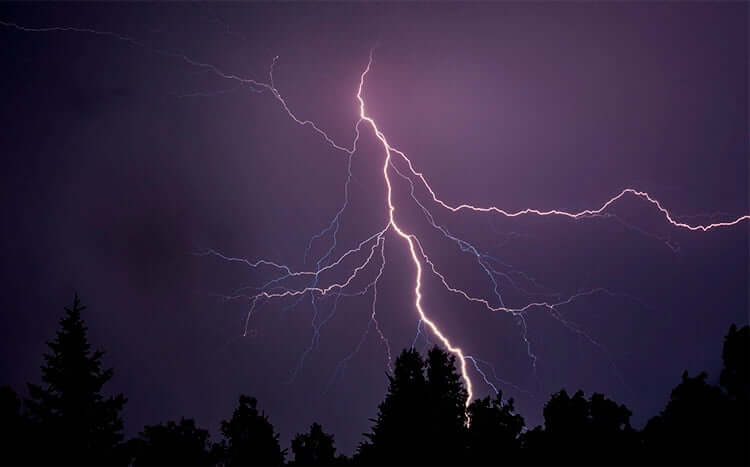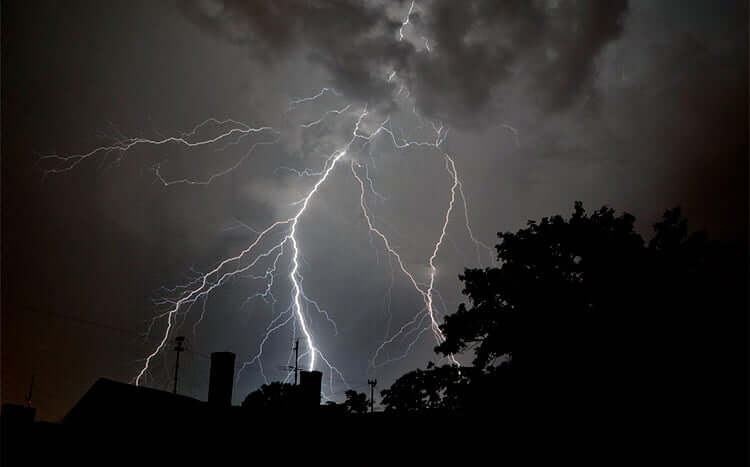You have every reason to be worried about lightning striking your tree especially if it is near a house or relatively old and valuable. Lightning can destroy an otherwise healthy mature tree in an instant.
The most common lightning protection systems for trees consist of heavy gauge insulated copper wires running the length of a tree and connected to the ground using a series of copper rods. Since tree height will increase over time, the grounding copper wire is designed to expand with time. The system prevents lightning currents from going through the tree.
Most people are not aware that large trees can be protected from lightning the same way tall buildings, communication masts, and other things are protected. You can prevent lightning currents from going through a tree using a grounding system like what you see on a building or mast.
Lightning protection systems for trees vary from one manufacturer to another but they all operate on the same principle. They consist of a series of copper conductors running through the length of the tree to the highest branches. The copper wires are then connected to one or more grounding copper rods buried in the ground.
If lightning strikes a tree with lightning protection installed, the current will be captured and diverted to the heavy-duty copper conducting cables for grounding. It is a simple but very effective system that anyone can use to protect their trees. These systems are usually installed on large or mature trees prone to lightning strikes.

Protecting Trees from Lightning
You can purchase a ready-to-install lightning protection system for your trees. These systems are designed to be non-injurious to the tree and inconspicuous. Storm damage to trees is serious stuff and needs to be avoided where possible for safety reasons.
A standard lightning protection system for trees has the following key components:
Heavy-duty electrical conductor cables (copper)
Heavy-duty copper cable conductors that are designed for outdoor installations are installed from the top to the bottom of the tree. These cables will direct any lightning current from the top of the tree to the ground.
Cable fasteners/standoffs
Cable fasteners or standoffs secure the cables to the tree. Different designs are available depending on the size and type of tree you are protecting. The standoffs are designed to allow for marginal expansion and contraction of the copper wire as the tree grows.
Clamp-type connectors
These are special cable connectors or joints used to connect different sections of the cable conductor. They have a spring mechanism that allows them to expand and allow the cable to stretch depending on the height of the tree.
Air Terminal
The air terminal is one of the main components of a tree lightning protection system. The air terminal is placed at the top of the tree to capture or intercept lightning strikes before they hit the tree. Some lightning protection systems have multiple air terminals placed on the tips of the highest tree branches.
Ground plate
The ground plates are used in place of copper rods for areas where the soil is too shallow. They are normally copper sheets about a fifth of an inch thick.
Ground rods
The ground is one of the most important components in a tree lightning protection system. The ground rod is a steel rod coated with copper. The ground rod is buried in the ground below the tree and connected to the conductor cable. It grounds the lightning electric current.
Ground rod clamps
Ground rod clamps are used to link the cable conductor to the ground plate or ground rods.
Tip: There are different tree lightning protection systems for a variety of trees and soil types. It’s advisable to consult an expert before you purchase and install these systems to be sure that you are using the correct one.

Can You DIY-Install Lightning Protection on A Tree?
No, it is recommended that tree lightning protection systems be installed by certified installers who are trained in electrical safety, work at height and understand how to work with trees. Strict laws exist prohibiting untrained and unauthorized people from handling electrical equipment.
FAQ's
Lightning usually strikes the tallest object or land feature on its path, including trees. Tall trees or buildings provide the nearest point or upward streamer that connects with the lightning bolt’s downward leader. Trees are the likeliest target because of their height and positioning.
A lightning bolt contains a live current that can destroy or burn objects in its path. When a lightning bolt strikes a wet tree, it causes the affected cells to boil and release steam which can sometimes cause an entire branch or trunk to explode. Lightning uses the tree as a ground and usually travels the entire length of a tree to the soil.
Trees damaged by lightning normally need removal and sometimes it may require emergency tree removal if they fall on a home or power lines.
Trees can survive a lightning strike if they are not severely injured or burned. However, urgent care is required to repair damaged branches, cover open bark and trim off damaged limbs.
Any tall tree in an open field or yard can be struck by lightning. However, statistics show that oak trees get hit by lightning more frequently than other species mainly because they tend to be the tallest.



